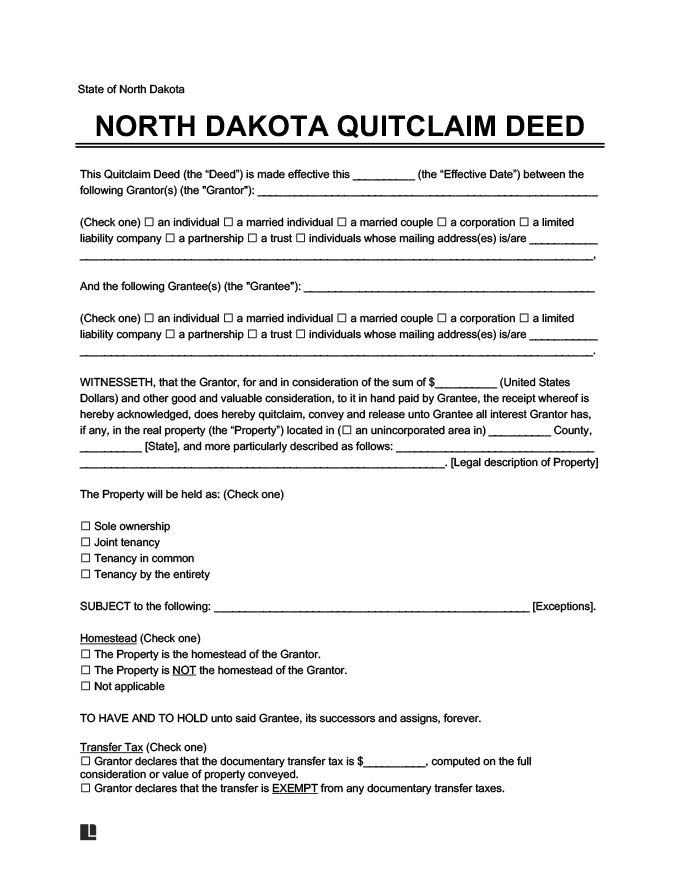Transferring property in North Dakota with a quitclaim deed can be a smooth process. This method streamlines the property transfer, sidestepping the convolutions often encountered with general warranty deed transactions.
Step 1 – Get the Original Real Estate Deed
To begin the quitclaim process, you must have a copy of the deed for the property you plan to convey. If you are not the owner, secure a copy of the deed from the property owner before you begin. You can also contact the county recorder’s office and request a copy of the official property deed.
Step 2 – Locate the Legal Property Description
Find the legal property description on the original deed and transfer it verbatim to your quitclaim deed form. N.D. Cent. Code § 11-18-05 states that a property cannot be transferred without this information.
If the property description uses metes and bounds, you must also include the name and address of the person who provided the description or indicate that you pulled it from the deed. Language for this statement can be found under N.D. Cent. Code § 47-19-03.1.
Step 3 – Write the Quitclaim Deed Form
Format and draft your North Dakota quitclaim deed consistent with formatting requirements under N.D. Cent. Code § 11-18-05. The document should be legibly printed or written in 10-point Calibri or larger type on pages no larger than 8 ½ in. x 14 in. Leave a 3 in. space at the top of the first page for recorder information and ensure the rest of the margins are 1 in. each.
Complete the form with the required indexing information, per N.D. Cent. Code § 11-18-08. Content should include:
- Grantor’s name
- Grantee’s name and address
- Property description
- Conveying language and covenants
- Consideration
Language for quitclaim deeds in North Dakota can be pulled from N.D. Cent. Code § 47-10-06. However, the term “grant” implies covenants not offered in a typical quitclaim. Consider replacing the term with “quitclaim and release” or similar language to avoid unintended warranties.
Start by downloading a quitclaim deed template. The document auto-fills appropriate language for quitclaim deeds in North Dakota, so you only need to fill in the information specific to your situation.
Step 4 – Sign and Notarize the Quitclaim Deed
A North Dakota quitclaim deed is only valid when signed by the grantor, per N.D. Cent. Code § 47-19-03. The document must be signed in the presence of a notary and acknowledged consistent with N.D. Cent. Code § 47-19-27. If a notary is not available, the grantor can sign before a subscribing witness in accordance with N.D. Cent. Code § 47-19-22.
If the grantor is married and the property is considered a homestead under N.D. Cent. Code § 47-18-05, both spouses must sign the quitclaim deed conveying the property.
Step 5 – Obtain the Auditor’s Certificate
If the North Dakota quitclaim deed transfers property with consideration, you must pay any taxes owed and obtain a certificate from the county auditor [1]. This certificate is required for the county recorder to process the deed, pursuant to N.D. Cent. Code § 11-18-02.
Documents exempt from the auditor’s certificate requirement are listed under N.D. Cent. Code § 11-18-03. They include:
- Certificate of sale on execution or foreclosure of a mortgage
- Mineral deeds
- Personal representative’s deed or termination of joint tenancy or a life estate
- A deed conveying property to the state or a subdivision or corporation thereof
- Plat, replat, or auditor’s lot modifications requested by a political subdivision
- Statement of succession for minerals abandoned per N.D. Cent. Code § 38-18.1
- Transfer on death deed
Step 6 – Submit the Executed Deed to the County Recorder
Complete the transfer of property interest by submitting the fully executed deed to the county recorder [2] in the county where the property is located, per N.D. Cent. Code § 11-18-11.
